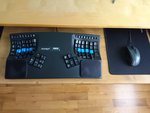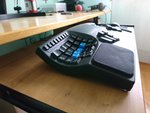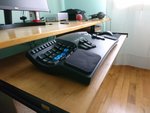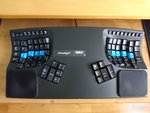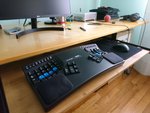Aug 22,
2020
What Has Two Thumbs And A Kinesis Advantage2?
This guy!
I know, I know, the joke was stale the first time I used it, I promise I won't do it again.
So, how is it? For starters, it's surprisingly light for its dimensions and much louder than I expected. My TECK is whisper quiet in comparison and both use Cherry Brown switches, so the noise isn't from the switches themselves. Rather, the shape and all the empty space inside act like a resonance chamber, even though I usually don't bottom out when typing. I wonder if filling the inside with foam or similar materials could dampen the noise — I think I've seen at least one person on the Interweb who showed pictures of an Advantage keyboard stuffed with pieces of cloth.
Regarding the dimensions, it's sensibly taller than my TECK, I would guess its height is about that of three membrane keyboards stacked one on top of the other. Unless you use a height-adjustable desk, I would advise following the manual's suggestion and placing it on a keyboard tray attached under the desk, as I ended up doing. Yeah, I'm the kind of guy who actually reads manuals.
In my opinion, the two thumb clusters are somewhat better than those on an Ergodox, but I would have liked them more if they were rotated a few degrees further — clockwise on the left cluster and counterclockwise on the right.
I'll be honest: at first, I thought having the backspace on the left thumb cluster wasn’t a great idea, but after a few days of use, I started to get the means of it. As for the cursor movement keys’ position, I can’t say I’m a fan. Also, I much prefer the symmetric layout of the modifier keys — Ctrl, Shift, and Alt — on the TECK. On the same note, to use the "Super" modifier, the Gnome leader key, I'm forced to sacrifice one of the two Alt keys. Additionally the Esc key is in a such uncomfortable position and it's considered a second class citizen by Kinesis1 that I remapped the Caps Lock to be another Esc key. Even so I can tell you that is barely usable in Emacs and even in the shell sometimes I would prefer to have an Alt key on the right side of the keyboard.
Another thing I've noticed about the keyboard layout, at least for my hands, is that it's somewhat difficult to make a Ctrl-Shift chord.
About the material used, the key-caps plastic is not bad, but at the same time not exceptional. I would say POM or similar hard plastic with the labels printed on the keys, but no double-shots. I like the blue accent of the keys on the home row, but even if they have a different sculpt to distinguish from the other keys, I would have preferred the classic notch on the F and J to confirm the fingers are on the home row. Sadly no Colemak layout option available even with offering cash, only Dvorak, no surprise there, I know I belong to a niche group of a niche group. Believe me when I say that more than once, coworkers have olled their eyes when I entertained the idea of using layouts other than Qwerty. And they hate me when they start writing on a PC and there's gibberish on the screen.
Anywho, back to my impressions, there is a macro function integrated in the keyboard that could turn out useful, but I have not yet tried to play with it, although it seems more plain than the functions available with the QMk firmware. In my opinion, the clicking tone seems useless, didn't I already write that this thing is loud? I wonder if the internal speaker could be used for other things.
The function keys, if you ask me, still seem a second thought, they are better than el-cheapo first gen rubber buttons, but I'll never be able to touch type with them, they are too far away from the number key row and they are spaced too far apart from each other. The keys with an even number have a little notch in the base, but it's useless in my opinion.
So if you have all read till now you are probably interested in the verdict. So, aiming to be better than a staggered keyboard is placing the bar too low, so yes it's way better than a vanilla run of the mill two centuries old layout membrane USB keyboard, but in my opinion is not the perfect keyboard. Let's see, I would put the two well clusters under "the good", the lacks of full symmetric modifiers under to "the bad" and finally, the function keys to "the ugly" category.
I made a couple of shots of the tray that I literally hacked to my desk, if someone is curious.
P.S. for the record, I purchased the keyboard myself, it's not a test sample generously donated by the manufacturer.
A few weeks later...
After a few weeks of use, I would say — probably against popular opinion — that my old TECK is more comfortable. Also, as you can see in the photos, the two wrist foam pads are starting to look gross, considering I have only been using it for a few weeks. Imagine what they’ll look like after a year.
If you’re wondering, the Ergodox is tucked away in a drawer, collecting dust. I used it for a very short time because, unfortunately, I didn’t find it very comfortable.
-
in the first Advantage keyboard model the function keys are riduculosly rubber button bad, in this model the buttons have a spring but are tiny, so forget to touch type with them ↩
